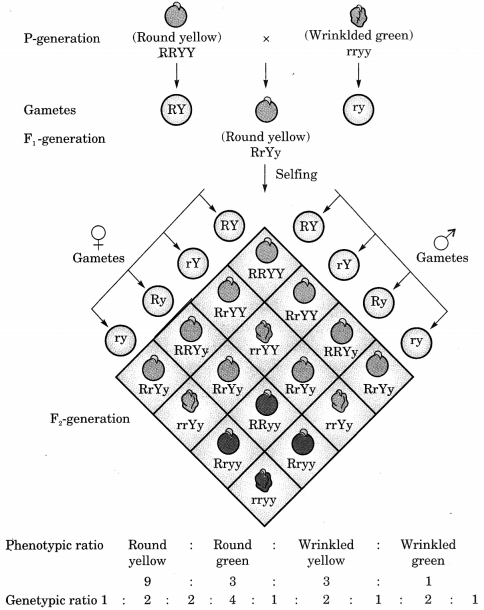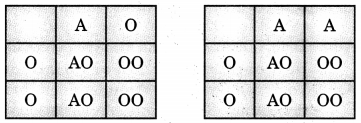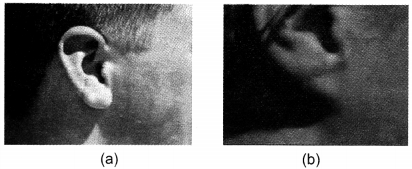BSEB Bihar Board Class 10 Science Solutions Chapter 9 Heredity and Evolution Textbook Questions and Answers.
Bihar Board Class 10 Science Solutions Chapter 9 Heredity and Evolution
Bihar Board Class 10 Science Chapter 9 Heredity and Evolution InText Questions and Answers
In-text Questions (Page 143)
Question 1.
If a trait A exists in 10% of a population of an asexually reproducing species and a trait B exists in 60% of the same population, which trait is likely to have arisen earlier?
Answer:
Trait B is present in a greater percentage of the population, so trait B is likely to have arisen earlier.
Question 2.
How does the creation of variations in a species promote survival?
Answer:
Variations arise in the offsprings due to the inaccuracies which occur during the process of DNA replication. The favourable variations enable the organism to survive under adverse conditions and these variations are passed on to their progeny which promotes the survival of the species.
Example: The in-built variations present in the colony of bacterial cells enable them to develop antibiotic resistance in some cases.
In-text Questions (Page 147)
Question 1.
How do Mendel’s experiments show that traits may be dominant or recessive?
Answer:
Mendel crossed pure tall pea plant (TT) with pure dwarf plant (tt) and observed in F1 generation a progeny which was hybrid tall (Tt). This showed that only one of the traits was able to express itself in the F1 generation i.e., tallness. The recessive dwarf trait was not able to express itself in the F1 generation but reappeared in the F2 generation on selfing the hybrid F1 plants.
Question 2.
How do Mendel’s experiments show that traits are inherited independently?
Answer:
When Mendel crossed pea plant with round-yellow seeds (RRYY) with wrinkled-green seeds (rryy), all the progeny obtained in F1 generation was RrYy (round and yellow seeds). On self-pollination of F1 plants (RrYy), a phenotypic ratio of 9 : 3 : 3 : 1 for round-yellow, round-green, wrinkled-yellow and wrinkled-green pea seeds respectively were obtained. On the basis of the above experiments, Mendel concluded that round and yellow seeds have dominant characters. Occurrence of new phenotypic combinations shows that genes for round and yellow seeds are inherited independently of each other.

Question 3.
A man with blood group A marries a woman with blood group O and their daughter has blood group O. Is this information enough to tell you which of the traits – blood group A or O – is dominant? Why or why not?
Answer:
The information is not sufficient to tell whether trait A or trait 0 is dominant.

Case I: If the blood group A is considered dominant over O, then the combinations possible are given alongside. The males are AO and females are OO. So, the daughters will have blood group O due to the presence of OO in them.
Case II: If the blood group O is considered dominant over A, then the combinations possible again show that child may have blood group O.
Since, in both the combinations it is possible for the child to have blood group O, it becomes difficult to establish which trait is dominant.
Question 4.
How is the sex of the child determined in human beings?
Answer:
In human beings the sex is genetically determined. Human male produces half of the gametes with X chromosome and half with Y chromosome. Human female produces all the gametes having X chromosome. When a sperm carrying X chromosome fertilises an ovum carrying X chromosome, the child born will be a girl (XX). When a sperm carrying Y chromosome fertilises an ovum carrying X chromosome, the child born will be a boy (XY).

In-text Questions (Page 150)
Question 1.
What are the different ways in which individuals with a particular trait may increase in a population?
Answer:
The individuals with a particular trait may increase in a population by
- Inheritance
- Natural selection
Question 2.
Why are traits acquired during the lifetime of an individual not inherited?
Answer:
The traits acquired during the lifetime of an individual are not inherited because they occur in non- reproductive cells of the organism. No change occurs in the DNA of the organism when the traits are acquired, so such traits are not passed on to the progeny.
Question 3.
Why are the small numbers of surviving tigers a cause of worry from the point of view of genetics?
Answer:
The small number of tigers is a cause of worry because if they die and become extinct then their genes will be lost forever. This will lead to loss of biodiversity and can create an imbalance in nature and its processes too.
In-text Questions (Page 151)
Question 1.
What factors could lead to the rise of a new species?
Answer:
The factors which lead to the rise of a new species are:
- Natural selection
- genetic drift
- reproductive isolation.
Question 2.
Will geographical isolation be a major factor in the speciation of a self-pollinating plant species? Why or why not? [CBSE 2012, 2013]
Answer:
A self-pollinating species does not depend on other plant for getting pollinated, so geographical isolation will not be a major factor in its speciation.
Question 3.
Will geographical isolation be a major factor in the speciation of an organism that reproduces asexually? Why or why not?
Answer:
An asexually reproducing organism does not depend on other organism for its reproductive process, so geographical isolation will not be a major factor in its speciation.
In-text Questions (Page 156)
Question 1.
Give an example of characteristics being used to determine how close two species are in evolutionary terms.
Answer:
The homologous organs help to determine the closeness of species in evolutionary terms as they have a common ancestor. For example, the structural similarity in the forelimbs of frogs, lizards, birds and humans points out to their relationship during evolution.
Question 2.
Can the wing of a butterfly and the wing of a bat be considered homologous organs? Why or why not?
Answer:
Homologous organs have a similar structure and a common ancestor but are different in their functions. Analogous organs have different structure and ancestors but perform a similar function. Since, the wing of a bat and wing of butterfly are different in structure but perform the same function of flying, they are said to be analogous organs and not homologous organs.
Question 3.
What are fossils? What do they tell us about the process of evolution?
Answer:
The remains or impressions of the dead animals or plants that lived in the remote past are called fossils. The fossils provide an evidence for evolution and help to establish the evolutionary relationships among the various groups of organisms.
In-text Questions (Page 158)
Question 1.
Why are human beings who look so different from each other in terms of size, colour and looks said to belong to the same species?
Answer:
Human beings who look so different from each other in terms of size, colour and looks are said to belong to the same species as they can interbreed among themselves and produce fertile offsprings.
Question 2.
In evolutionary terms, can we say which among bacteria, spiders, fish and chimpanzees have a ‘better’ body design? Why or why not?
Answer:
Though the more complex body designs have evolved over time, it does not mean that the older designs are inefficient. The older forms still survive along with the newer forms. For example, bacteria are most primitive forms which are able to survive even in harsh habitats like hot springs or polar ice caps. So, it is not possible to say which among bacteria, spiders, fish and chimpanzees have a ‘better’ body design. All of them have evolved a body design which is best suited according to the environmental conditions and the mode of life they have adopted during the course of evolution.
Bihar Board Class 10 Science Chapter 9 Heredity and Evolution Textbook Questions and Answers
Question 1.
A Mendelian experiment consisted of breeding tall pea plants bearing violet flowers with short pea plants bearing white flowers. The progeny all bore violet flowers, but almost half of them were short. This suggests that the genetic make-up of the tall parent can be depicted as
(a) TTWW
(b) TTww
(c) TtWW
(d) TtWw
Answer:
(c) TtWW
Question 2.
An example of homologous organs is
(a) our arm and a dog’s fore-leg.
(b) our teeth and an elephant’s tusks.
(c) potato and runners of grass.
(d) all of the above.
Answer:
(d) all of the above.
Question 3.
In evolutionary terms, we have more in common with
(a) a Chinese school-boy.
(b) a chimpanzee.
(c) a spider.
(d) a bacterium.
Answer:
(a) a Chinese school-boy.
Question 4.
A study found that children with light-coloured eyes are likely to have parents with light- coloured eyes. On this basis, can we say anything about whether the light eye colour trait is dominant or recessive? Why or why not?
Answer:
Since, children with light-coloured eyes are likely to have parents with light-coloured eyes. On this basis we can say that light eye colour trait is dominant.
Question 5.
How are the areas of study-evolution and classification-interlinked?
Answer:
Classification is the grouping of organisms on the basis of their similarities and differences. Organisms which share similar characteristics are placed in one group and considered to be more closely related evolutionary than the members of the other groups. So, evolution and classification are interlinked.
Question 6.
Explain the terms analogous and homologous organs with examples.
Answer:
Homologous organs: Organs having the same basic structure but different functions are called as homologous organs. They have a common origin (common ancestor).
Example: Forelimbs of man, a lizard, a frog and a bird have the same basic structure and design but perform different functions.
Analogous organs: Organs which perform the same function but have different basic structure are called analogous organs: They have a different origin (different ancestors).
Example: The wings of insect and the wings of bird have different structure but perform the same function of flying.
Question 7.
Outline a project which aims to find the dominant coat colour in dogs.
Answer:
The experiment can be designed in which dogs having pure black colour coat (BB) are crossed with dogs having pure white colour coat (bb) to obtain the F1 progeny. If all the dogs obtained in the F1 generation are black in colour, we can conclude that black coat colour is dominant in dogs. But, if all the dogs in F1 generation are white in colour, then white coat colour will be considered as dominant.
Question 8.
Explain the importance of fossils in deciding evolutionary relationships.
Answer:
The remains or impressions of the dead animals or plants that lived in the remote past are called fossils. The fossils provide an evidence for evolution and help to establish the evolutionary relationships among the various groups of organisms. On digging into the Earth, the fossils we find closer to the surface are more recent than the fossils we find in deeper layers, this helps us to ascertain the time in history when different species were formed or became extinct.
Question 9.
What evidence do we have for the origin of life from inanimate matter?
Answer:
The experiment carried out by Stanley L. Miller and Harold C. Urey provides an evidence for the origin of life from inanimate matter.
Question 10.
Explain how sexual reproduction gives rise to more viable variations than asexual reproduction. How does this affect the evolution of those organisms that reproduce sexually?
Answer:
Asexual reproduction produces a progeny which are genetically identical to their parents. No variations occur in them due to which they are more vulnerable under adverse conditions. Sexual reproduction is a process in which fusion of gametes which are genetically dissimilar, takes place. Such a fusion of gametes results in variations which enable the organism to withstand adverse conditions. This also causes accumulation of variations over a period of time which consequently result in the evolution of new species.
Question 11.
How is the equal genetic contribution of male and female parents ensured in the progeny?
Answer:
Gametes are produced by cell division called meiosis in the male and female reproductive cells. The gametes have equal genetic material. Both male and female gametes contribute equal genetic content during their fusion to form a zygote. Zygote develops into an embryo and later into an individual. Hence, equal genetic contribution of male and female parents are ensured in the progeny.
Question 12.
Only variations that confer an advantage to an individual organism will survive in a population. Do you agree with this statement? Why or why not?
Answer:
Yes, only variations that confer an advantage to an individual organism will survive in a population. The favourable variations enable the organism to withstand the adverse conditions, ensure its survival and help to transfer them to their progeny. The variations which do not confer an advantage will not be able to help the organism to survive under adverse conditions, and would ultimately get eliminated from the population along with the organism.
Bihar Board Class 10 Science Chapter 9 Heredity and Evolution Textbook Activities
Activity 9.1 (Textbook page 143)

The presence of attached ear lobe is a recessive trait. The organisms with free ear lobe show the dominant trait. The recessive traits express themselves only in homozygous condition. So, the Law of Dominance given by Mendel will apply and the offsprings will have the traits as shown below:
| Type of gene/allele | Trait produced in offspring |
| AA | Free ear lobe |
| Aa | Free ear lobe |
| aa | Attached ear lobe |
Activity 9.2 (Textbook page 144)
The experiment done to confirm will be called as the test cross. It involves crossing the individuals obtained in the F2 generation with the parent with ‘tt’ as trait combination. The individuals having tt trait combination would be visible as dwarfs. The confusion of the tall plants- TT and Tt trait combination can be resolved by the test cross. The individuals having TT trait combination will give rise to all tall progeny after crossing with tt trait combination. The individuals with Tt trait combination will produce 50% progeny tall and 50% progeny dwarf after the cross with tt trait combination.